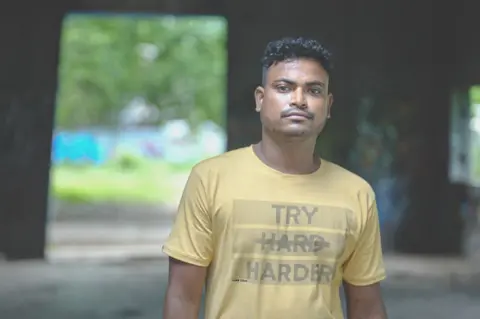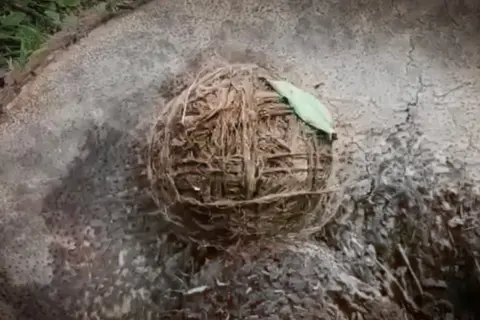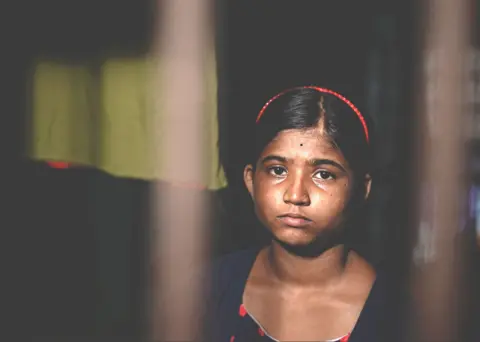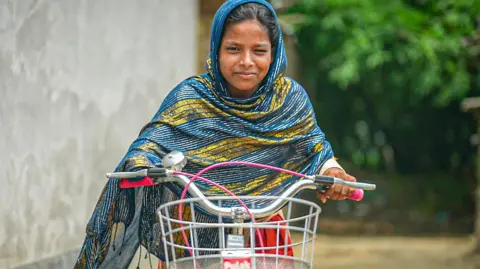 Ronny Sen for the BBC
Ronny Sen for the BBCOver the last three decades, at least 565 children in the Indian state of West Bengal have been injured or killed by home-made bombs, a BBC Eye investigation has found.
So what are these deadly devices and how are they linked to political violence in West Bengal? And why are so many Bengali children paying the price?
On a bright summer morning in May 1996, six boys from a slum in Kolkata, the capital of India’s West Bengal state, stepped out to play cricket in a narrow alley.
Their shantytown, nestled in the middle-class neighbourhood of Jodhpur Park, thrummed with life. It was a holiday – voting day in a general election.
Nine-year-old Puchu Sardar, one of the boys, grabbed a cricket bat and quietly slipped past his sleeping father. Soon, the cracking noise of bat meeting ball echoed through the alley.
A ball batted out of the boundaries of their makeshift pitch sent the boys searching for it in a small garden nearby. There, in a black plastic bag, they found six round objects.
They looked like cricket balls someone had left behind, and the boys returned to the game with their spoils.
One of the “balls” from the bag was bowled at Puchu who struck it with his bat.
A deafening explosion tore through the alley. It was a bomb.
As the smoke lifted and neighbours rushed outside, they found Puchu and five of his friends sprawled on the street, their skin blackened, clothes scorched, bodies torn.
Screams pierced the chaos.
Seven-year-old Raju Das, an orphan raised by his aunt, and seven-year-old Gopal Biswas died of their injuries. Four other boys were wounded.
Puchu narrowly survived, having suffered serious burns and shrapnel wounds to his chest, face and abdomen.
He spent over a month in hospital. When he came home he had to use kitchen tongs to remove shrapnel still lodged in his body because his family had run out of money to pay for any more medical care.
Puchu and his friends are part of a long, tragic list of children killed or maimed by crude bombs, which have been used in West Bengal for decades in a bloody battle for dominance in the state’s violent politics.
There are no publicly-available figures on the number of casualties in West Bengal.
So the BBC World Service went through every edition of two prominent state newspapers – Anandabazar Patrika and Bartaman Patrika – from 1996 to 2024, looking for reports of children injured or killed by these devices.
We found at least 565 child casualties – 94 deaths and 471 injuries – as of 10 November. This means a child has fallen victim to bomb violence, on average, every 18 days.
However, the BBC has found incidents in which children were wounded by these bombs that were not reported by the two newspapers, so the real number of casualties is likely to be higher.
More than 60% of these incidents involved children playing outdoors – gardens, streets, farms, even near schools – where bombs, typically used during elections to terrorise opponents, were hidden.
Most victims the BBC spoke to were poor, the children of house-help, odd-jobbers, or farm workers.
The revolutionary history of bombs in West Bengal
West Bengal, India’s fourth-largest state with a population of more than 100 million, has long struggled with political violence.
Over the years, since India’s independence in 1947, the state has cycled through different rulers – the Congress party for two decades, the Communist-led Left Front for three, and the current Trinamool Congress since 2011.
In the late 1960s, the state was wracked by armed conflict between Maoist rebels – also called Naxalites – and government forces.
A common thread across all governments and rebel conflicts since then has been the use of bombs as tools of intimidation by political parties to silence opponents, especially during elections.
“Bombs have been [used to settle scores]. This has been happening in Bengal for a long time, more than 100 years,” Pankaj Dutta, a former Inspector General of West Bengal police, told us.
 Ronny Sen for the BBC
Ronny Sen for the BBCBomb-making in Bengal has its roots in the rebellion against British rule in the early 1900s.
Early efforts were crude and accidents were common: One rebel lost a hand and another died testing a bomb.
Then a rebel returned from France armed with bomb-making skills.
His book bomb – a legal tome loaded with explosives hidden in a Cadbury cocoa tin – would have killed its target, a British magistrate, if he had opened it.
The first explosion rocked Midnapore district in 1907, when revolutionaries derailed a train carrying a senior British official by planting a bomb on the tracks.
A few months later, a botched attempt to kill a magistrate in Muzaffarpur with a bomb hurled into a horse-drawn carriage claimed the lives of two Englishwomen.
The act, described by a newspaper as a “tremendous explosion that startled the town,” had turned a teenage rebel called Khudiram Bose into a martyr and the first “freedom fighter” in the pantheon of Indian revolutionaries.
Bal Gangadhar Tilak, a nationalist leader, wrote in 1908 that bombs were not just weapons but a new kind of “magical lore,” a “witchcraft” spreading from Bengal to the rest of India.
Today, Bengal’s crude bombs are known locally as peto. They are bound with jute strings and stuffed with shrapnel-like nails, nuts and glass.
Variations include explosives packed into steel containers or glass bottles. They are used primarily in violent clashes between rival political parties.
Political activists, particularly in rural areas, use these bombs to intimidate opponents, disrupt voting stations, or retaliate against perceived enemies.
They are often deployed during elections to sabotage polling booths or to assert control over areas.
 Ronny Sen for the BBC
Ronny Sen for the BBCChildren like Poulami Halder bear the brunt of such violence.
On an April morning in 2018, the-then seven-year-old was picking flowers for morning prayers in Gopalpur, a village in the North 24 Parganas district dotted with ponds, paddy fields, and coconut trees. Village council elections were barely a month away.
Poulami saw a ball lying near a neighbour’s water pump.
“I picked it up and brought it home,” she recalls.
As she stepped inside, her grandfather, sipping tea, froze at the sight of the object in her hand.
“He said, ‘It’s not a ball – it’s a bomb! Throw it away!’ Before I could react, it exploded in my hand.”
The blast shattered the quiet of the village. Poulami was struck in the “eyes, face, and hands” and fainted, as chaos erupted around her.
“I remember people running towards me, but I could see very little. I was hit everywhere.”
Villagers rushed her to the hospital.
Her injuries were devastating – her left hand was amputated, and she spent nearly a month in hospital.
An ordinary morning routine had turned into a nightmare, forever altering Poulami’s life in a single, shattering moment.
 Ronny Sen for the BBC
Ronny Sen for the BBCPoulami is not alone.
Sabina Khatun was 10 years old when a crude bomb exploded in her hand in April 2020 in Jitpur, a village flanked by rice and jute fields in Murshidabad district.
She had been taking her goat out to graze when she stumbled upon the bomb lying in the grass. Curious, she picked it up and began playing with it.
Moments later, it detonated in her hands.
“The moment I heard the explosion, I thought, who’s going to be disabled this time? Has Sabina been maimed?,” her mother, Ameena Bibi, says, her voice heavy with anguish.
“When I stepped outside, I saw people carrying Sabina in their arms. The flesh was visible from her hand.”
Doctors were forced to amputate Sabina’s hand.
Since returning home, she has struggled to rebuild her life, her parents consumed by despair over an uncertain future. Their fears are not unwarranted: In India, women with disabilities often face social stigma that complicate their prospects for marriage and jobs.
“My daughter kept crying, saying she would never get her hand back,” says Ameena.
“I kept consoling her, telling her, ‘your hand will grow back, your fingers will grow back.'”
Now, Sabina grapples with the loss of her hand and the struggle with simple daily tasks. “I struggle with drinking water, eating, showering, getting dressed, going to the toilet.”

The children of the bombs
In the Indian state of West Bengal, children are routinely maimed, blinded, or killed by home-made bombs. BBC Eye investigates the political violence that underlies this tragedy and asks why the carnage is allowed to continue.
Watch on iPlayer or, if you are outside the UK, watch on YouTube
Maimed by bombs yet lucky to survive, these children have had their lives changed forever.
Poulami, now 13, received an artificial hand but couldn’t use it – too heavy and quickly outgrown. Sabina, 14, struggles with failing eyesight.
Her family says she needs another operation to remove bomb debris from her eyes, but they cannot afford it.
Puchu, now 37, was pulled out of school by his fearful parents and spent years refusing to step outside, often hiding under his bed at the slightest noise.
He never picked up a cricket bat again. His childhood stolen, he’s now scraping by with odd construction jobs and bears the scars of his past.
But all hope is not lost.
Poulami and Sabina have both learned to ride a bicycle with one hand and continue to go to school. Both dream of becoming teachers. Puchu hopes for a brighter future for his son, Rudra, five, – a future in uniform as a policeman.
 Ronny Sen for the BBC
Ronny Sen for the BBCDespite the terrible toll it inflicts, there is no sign of crude bomb violence in West Bengal ending.
None of the political parties admit to using bombs for political gain.
When the BBC asked the four main political parties in West Bengal whether they were involved, directly or through intermediaries, in manufacturing or using crude bombs, the ruling Trinamool Congress (TMC) and the opposition Bharatiya Janata Party (BJP) did not respond.
The Communist Party of India (Marxist) (CPI-M) strongly denied being involved, saying it was “committed to upholding the rule of law…and that when it comes to protecting rights and lives, children are of the utmost concern”.
The Indian National Congress (INC) also strongly denied using crude bombs for electoral advantage, and said it had “never engaged in any violence for political or personal gain”.
Although no political party will admit responsibility, none of the experts who spoke to the BBC is in any doubt this carnage is rooted in Bengal’s culture of political violence.
“During any major election here you will see the rampant use of bombs,” Pankaj Dutta told us. “Extreme abuse of childhood is going on. It is a lack of care on the part of the society.” Mr Dutta passed away in November.
Poulami adds: “Those who planted the bombs are still free. No one should leave bombs lying around. No child should ever be harmed like this again.”
‘Look what they have done to my son’
But the tragedy continues.
In May this year in the Hooghly district, three boys playing near a pond unknowingly stumbled upon a cache of bombs. The explosion killed Raj Biswas, nine, and left his friend maimed, missing an arm. The other boy escaped with leg fractures.
“Look what they have done to my son,” Raj’s grieving father sobbed as he caressed the forehead of his dead child.
As Raj’s body was lowered into a grave, political slogans crackled through the air from a nearby election rally: “Hail Bengal!” the crowd chanted, “Hail Bengal!”
It was election time. And once again, children were paying the price.

